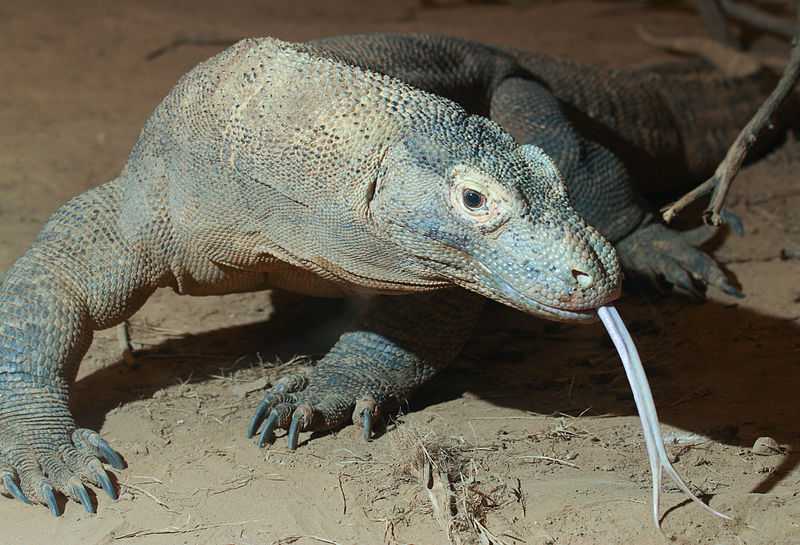
A study into the DNA of the Komodo dragon claims to provide insight into the “positive selection” adaptive evolution of the unique monitor lizard with a metabolism similar to that of mammals. Christian researchers, however, state that the study doesn’t point to evolution at all, but rather demonstrates the handiwork of the Creator.
The study was conducted by Gladstone Institutes, which worked with the University of California San Francisco (UCSF) and Zoo Atlanta to analyze the venomous cold-blooded predators. Scientists used blood samples from two Komodo dragons at Zoo Atlanta — Slasher and Rinca — to map out their genome sequence.
While most reptiles usually become tired after exerting energy, Komodo dragons — which can weigh up to 200 pounds and can detect prey from over seven miles away — have great endurance and speed and a metabolism that is more akin to warm-blooded creatures. Researchers wanted to find out why and to study what they characterized as the “evolution” of the lizard’s DNA.
“We started the project nine years ago to look at how genomes evolve, but to do so, we needed the genome sequences first,” Gladstone Senior Investigator Benoit Bruneau, one of the authors of the study, said in a statement. “At the time, other groups had sequenced the turtle genome, snake and bird genomes, and the crocodile genome was in process, but the missing branch was the varanid lizards — the family to which Komodo dragons belong.”
“Reptiles are kind of like a playground for evolution. There is so much diversity in size and form and behavior and their physiology,” Bruneau, a developmental biologist and cardiovascular disease researcher who also teaches at UCSF, further told Reuters.
Specifically, the research team wanted to find changes in the Komodo DNA that would suggest adaptation to its environment. It chalked its results up to evolutionary “positive selection” surrounding mitochondria, parts of the cell that help the heart and muscles to function at their peak by turning food into energy.
“Comparing the genome of V. komodoensis with those of related species, we find evidence of positive selection in pathways related to energy metabolism, cardiovascular homoeostasis, and haemostasis,” an abstract of the study states. “We also show species-specific expansions of a chemoreceptor gene family related to pheromone and kairomone sensing in V. komodoensis and other lizard lineages.”
“Together, these evolutionary signatures of adaptation reveal the genetic underpinnings of the unique Komodo dragon sensory and cardiovascular systems, and suggest that selective pressure altered haemostasis genes to help Komodo dragons evade the anticoagulant effects of their own saliva,” it remarks, the latter referring to the fact that while Komodos are venomous, the bite generally does not have the same adverse affect on one of their own.
“Our study showed us that the secret [to their energy and endurance] is in these mitochondrial adaptations to increase their cardiac output. This gives us an understanding of how these animals are able to do what we had been observing,” Joseph R. Mendelson III, the director of research at Zoo Atlanta, said in a statement.
“The significance of this study far exceeds Komodo dragons,” he added. “It gives us a framework to compare other sequenced animals and understand the genetic basis for how all their characteristics have evolved.”
According to the site CK-12, which teaches math, science and English to school students, evolutionary theory claims that reptiles, such as the Komodo dragon, evolved from amphibians (frogs, salamanders, etc. that evolved from developing fish ancestors) and that mammals and birds evolved from their “reptile-like ancestors.”
“The first reptiles evolved from an amphibian ancestor at least 300 million years ago. They laid amniotic eggs and had internal fertilization. They were the first vertebrates that no longer had to return to water to reproduce. They could live just about anywhere,” it states. “Mammals and birds both evolved from reptile-like ancestors. The first mammals appeared about 200 million years ago and the earliest birds about 150 million years ago.”
However, Christian News Network reached out to Answers in Genesis (AIG) and the Institute for Creation Research (ICR) for their take on the study, and both said that the findings do not point to evolution but rather the Book of Genesis.

Dr. Nathaniel Jeanson of AIG, who holds a PhD in cell and developmental biology from Harvard University, told Christian News Network that the genome sequence study is “a helpful scientific advance, yet evolutionary speculation masks the implications of the work.”
“Unfortunately, at the outset of this study, the authors assumed that the Komodo dragon had evolved from primitive, single-celled ancestors over millions of years,” he lamented. “Rather than test this hypothesis against the hypothesis that the Komodo dragon descended from lizard-like ancestors on board Noah’s Ark over a few thousand years, the authors immediately adopted the evolutionary framework without question.”
“Thus, they concluded that the genetic differences between the Komodo and other lizards were due to natural selection or other natural processes,” Jeanson explained. “They also concluded that similarities were due to descent from a common ancestor in the ancient past. Sadly, the authors made no attempt to explore whether some of these differences were created. Consequently, the actual life history of the Komodo dragon species is not found in the authors’ published conclusions. ”

Jeffrey Tomkins of ICR, who holds a Ph.D. in genetics from Clemson University, said that the researchers’ attribution of the Komodo dragon’s uniqueness to “positive selection” pushes God out of the picture — when He is actually the one who created the Komodo to be distinct. He noted that one’s environment can’t create new DNA code; only God can program His creatures.
“Because the gene variations were unique to the Komodo dragon and different from other reptiles, they are given the standard evolutionary magic word phrase ‘positive selection,'” he told Christian News. “A creature’s environment has no God-like capacity to create new useful genetic information for complex multi-genic traits. Evolutionists basically substitute the magic words ‘positive selection’ or ‘natural selection’ for something only an omnipotent God can do.”
Tomkins also believes that the data was skewed to favor evolution, while the genome sequences did not provide any evidence of evolution.
“[T]he researchers reported actually throwing out data in their selection analysis where the variation was ‘unreasonably high.’ So the data was actually manipulated to show less variability and more evolution,” he noted. “The stark reality is that these were Komodo dragon specific genes that were engineered to produce their unique God-given traits and no sign of evolution existed in the data even though the researchers cherry-picked it to favor evolution.”
“The even bigger grand evolutionary (phylogenetic) analysis the researchers did comparing the Komodo Dragon DNA to other reptiles, birds, and mammals actually made no evolutionary sense in the previously assumed evolutionary paradigm,” Tomkins explained. “The patterns and groupings were totally different than predicted by standard evolutionary myth.”
Jeanson said that he himself has studied the subject, and he believes that diversification according to one’s kind (Genesis 1:24) occurred following the biblical flood — and not in the evolutionary “hagfish to fish to amphibians to reptiles to mammals” sense that secular scientists put forward.
“Instead, we know from Scripture that the family tree of the Komodo goes back only a few thousand years to the ‘kinds’ brought on board Noah’s Ark,” he outlined. “In addition, I have independently found good genetic evidence that most of the genetic differences between the Komodo dragon and other lizards in this study were put there at Creation. Combined with the operation of simple, straightforward, and normal genetic processes, this species and many other lizard species would have rapidly diversified after the Flood.”
“With the Komodo dragon genome in hand, we can now pinpoint exactly which DNA differences were critical for its adoption of its unusual predatory ways,” Jeanson cheered. “And we might even be able to reconstruct when the Komodo dragon first appeared in history.”
Become a Christian News Network Supporter...


